sensor BMW 4 SERIES COUPE 2016 F32 Owner's Manual
[x] Cancel search | Manufacturer: BMW, Model Year: 2016, Model line: 4 SERIES COUPE, Model: BMW 4 SERIES COUPE 2016 F32Pages: 247, PDF Size: 5.26 MB
Page 19 of 247
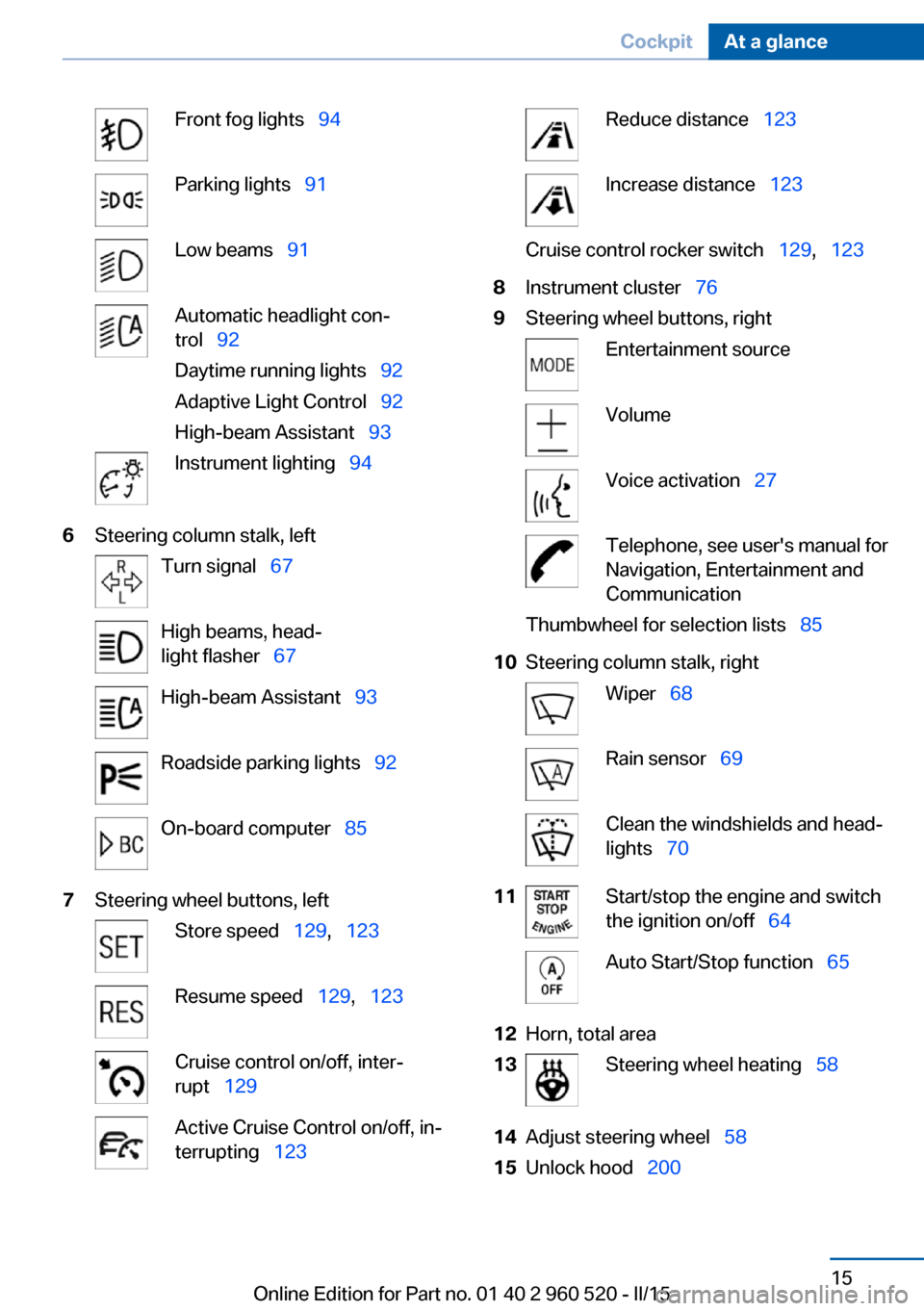
Front fog lights‚Äā‚ÄÖ94Parking lights‚Äā‚ÄÖ91Low beams‚Äā‚ÄÖ91Automatic headlight con‚Äź
trol‚Äā‚ÄÖ 92
Daytime running lights‚Äā‚ÄÖ 92
Adaptive Light Control‚Äā‚ÄÖ 92
High-beam Assistant‚Äā‚ÄÖ 93Instrument lighting‚Äā‚ÄÖ946Steering column stalk, leftTurn signal‚Äā‚ÄÖ67High beams, head‚Äź
light flasher‚Äā‚ÄÖ 67High-beam Assistant‚Äā‚ÄÖ 93Roadside parking lights‚Äā‚ÄÖ 92On-board computer‚Äā‚ÄÖ857Steering wheel buttons, leftStore speed‚Äā‚ÄÖ129,‚Äā‚ÄÖ123Resume speed‚Äā‚ÄÖ 129,‚Äā‚ÄÖ123Cruise control on/off, inter‚Äź
rupt‚Äā‚ÄÖ 129Active Cruise Control on/off, in‚Äź
terrupting‚Äā‚ÄÖ 123Reduce distance‚Äā‚ÄÖ 123Increase distance‚Äā‚ÄÖ 123Cruise control rocker switch‚Äā‚ÄÖ 129,‚Äā‚ÄÖ1238Instrument cluster‚Äā‚ÄÖ 769Steering wheel buttons, rightEntertainment sourceVolumeVoice activation‚Äā‚ÄÖ27Telephone, see user's manual for
Navigation, Entertainment and
CommunicationThumbwheel for selection lists‚Äā‚ÄÖ 8510Steering column stalk, rightWiper‚Äā‚ÄÖ68Rain sensor‚Äā‚ÄÖ 69Clean the windshields and head‚Äź
lights‚Äā‚ÄÖ 7011Start/stop the engine and switch
the ignition on/off‚Äā‚ÄÖ 64Auto Start/Stop function‚Äā‚ÄÖ 6512Horn, total area13Steering wheel heating‚Äā‚ÄÖ5814Adjust steering wheel‚Äā‚ÄÖ5815Unlock hood‚Äā‚ÄÖ200Seite 15CockpitAt a glance15
Online Edition for Part no. 01 40 2 960 520 - II/15
Page 42 of 247
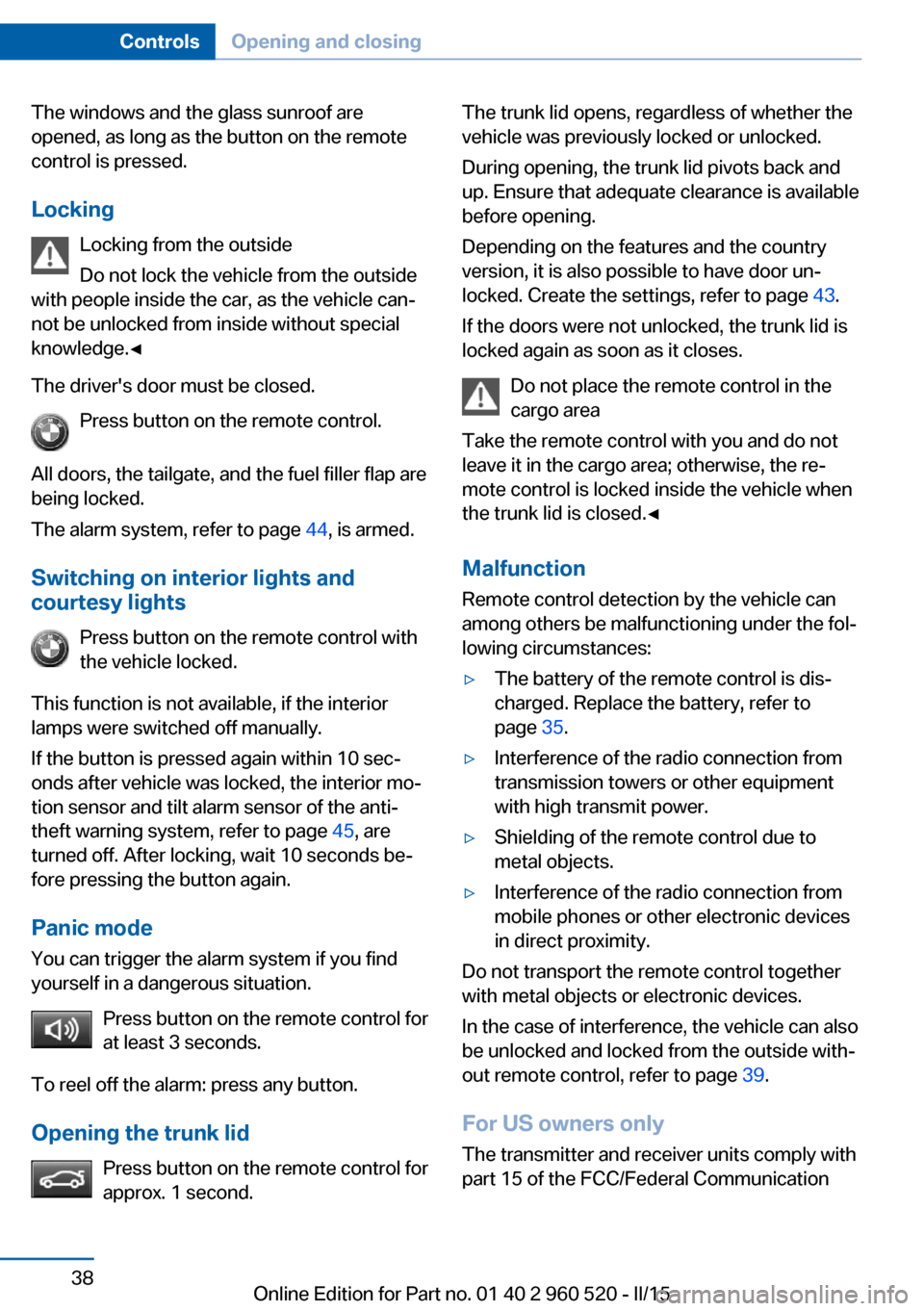
The windows and the glass sunroof are
opened, as long as the button on the remote
control is pressed.
Locking Locking from the outside
Do not lock the vehicle from the outside
with people inside the car, as the vehicle can‚Äź
not be unlocked from inside without special knowledge.‚óÄ
The driver's door must be closed. Press button on the remote control.
All doors, the tailgate, and the fuel filler flap are
being locked.
The alarm system, refer to page 44, is armed.
Switching on interior lights and
courtesy lights
Press button on the remote control with
the vehicle locked.
This function is not available, if the interior
lamps were switched off manually.
If the button is pressed again within 10 sec‚Äź
onds after vehicle was locked, the interior mo‚Äź
tion sensor and tilt alarm sensor of the anti-
theft warning system, refer to page 45, are
turned off. After locking, wait 10 seconds be‚Äź
fore pressing the button again.
Panic mode
You can trigger the alarm system if you find
yourself in a dangerous situation.
Press button on the remote control for
at least 3 seconds.
To reel off the alarm: press any button.
Opening the trunk lid Press button on the remote control for
approx. 1 second.The trunk lid opens, regardless of whether the
vehicle was previously locked or unlocked.
During opening, the trunk lid pivots back and
up. Ensure that adequate clearance is available
before opening.
Depending on the features and the country
version, it is also possible to have door un‚Äź
locked. Create the settings, refer to page 43.
If the doors were not unlocked, the trunk lid is
locked again as soon as it closes.
Do not place the remote control in the
cargo area
Take the remote control with you and do not
leave it in the cargo area; otherwise, the re‚Äź
mote control is locked inside the vehicle when
the trunk lid is closed.‚óÄ
Malfunction
Remote control detection by the vehicle can
among others be malfunctioning under the fol‚Äź
lowing circumstances:‚Ė∑The battery of the remote control is dis‚Äź
charged. Replace the battery, refer to
page 35.‚Ė∑Interference of the radio connection from
transmission towers or other equipment
with high transmit power.‚Ė∑Shielding of the remote control due to
metal objects.‚Ė∑Interference of the radio connection from
mobile phones or other electronic devices
in direct proximity.
Do not transport the remote control together
with metal objects or electronic devices.
In the case of interference, the vehicle can also
be unlocked and locked from the outside with‚Äź
out remote control, refer to page 39.
For US owners only
The transmitter and receiver units comply with
part 15 of the FCC/Federal Communication
Seite 38ControlsOpening and closing38
Online Edition for Part no. 01 40 2 960 520 - II/15
Page 46 of 247
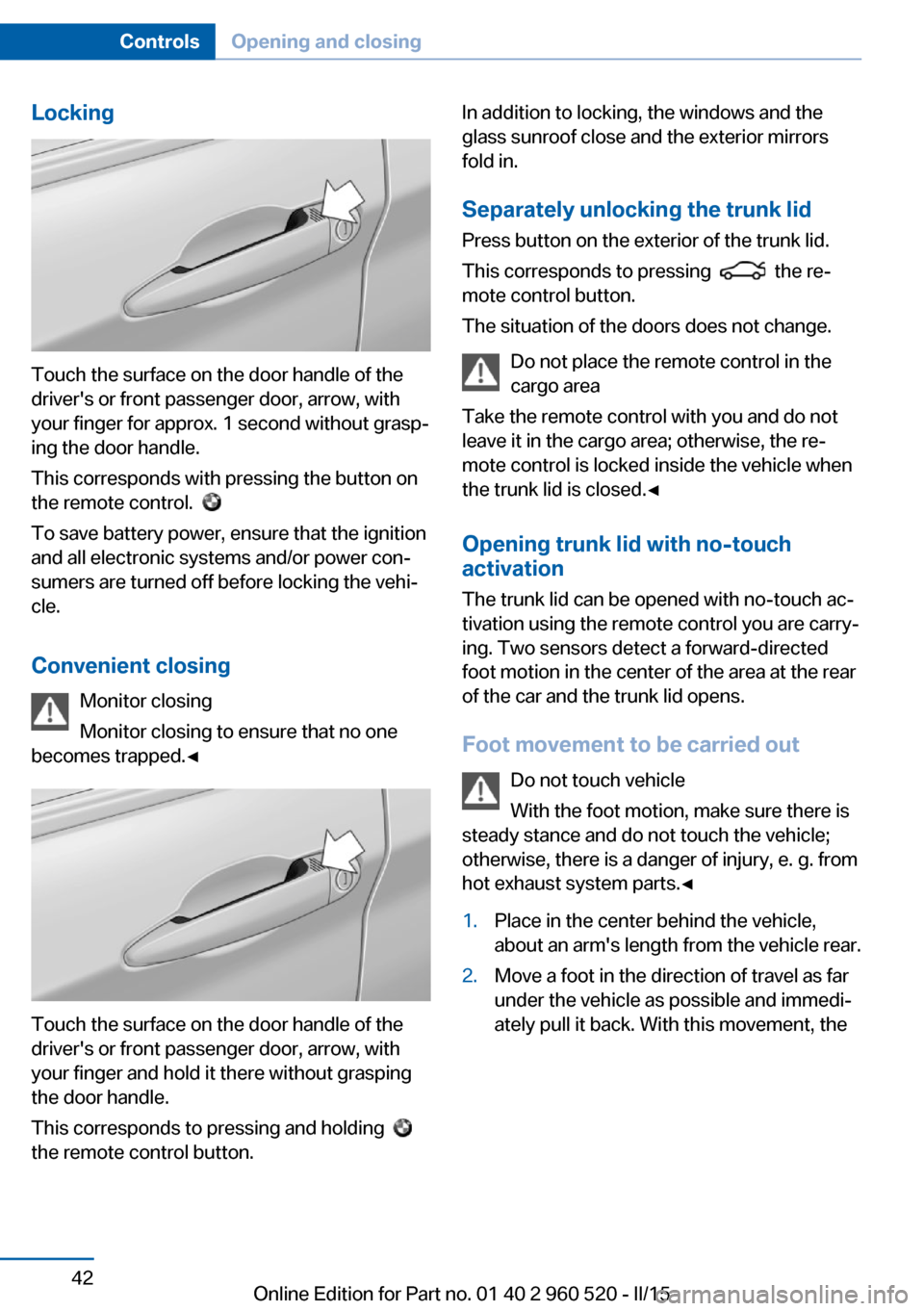
Locking
Touch the surface on the door handle of the
driver's or front passenger door, arrow, with
your finger for approx. 1 second without grasp‚Äź
ing the door handle.
This corresponds with pressing the button on
the remote control.
To save battery power, ensure that the ignition
and all electronic systems and/or power con‚Äź
sumers are turned off before locking the vehi‚Äź
cle.
Convenient closing Monitor closing
Monitor closing to ensure that no one
becomes trapped.‚óÄ
Touch the surface on the door handle of the
driver's or front passenger door, arrow, with
your finger and hold it there without grasping
the door handle.
This corresponds to pressing and holding
the remote control button.
In addition to locking, the windows and the
glass sunroof close and the exterior mirrors
fold in.
Separately unlocking the trunk lid Press button on the exterior of the trunk lid.
This corresponds to pressing
the re‚Äź
mote control button.
The situation of the doors does not change.
Do not place the remote control in the
cargo area
Take the remote control with you and do not
leave it in the cargo area; otherwise, the re‚Äź
mote control is locked inside the vehicle when
the trunk lid is closed.‚óÄ
Opening trunk lid with no-touch activation
The trunk lid can be opened with no-touch ac‚Äź
tivation using the remote control you are carry‚Äź
ing. Two sensors detect a forward-directed
foot motion in the center of the area at the rear
of the car and the trunk lid opens.
Foot movement to be carried out Do not touch vehicle
With the foot motion, make sure there is
steady stance and do not touch the vehicle; otherwise, there is a danger of injury, e. g. from
hot exhaust system parts.‚óÄ
1.Place in the center behind the vehicle,
about an arm's length from the vehicle rear.2.Move a foot in the direction of travel as far
under the vehicle as possible and immedi‚Äź
ately pull it back. With this movement, theSeite 42ControlsOpening and closing42
Online Edition for Part no. 01 40 2 960 520 - II/15
Page 47 of 247
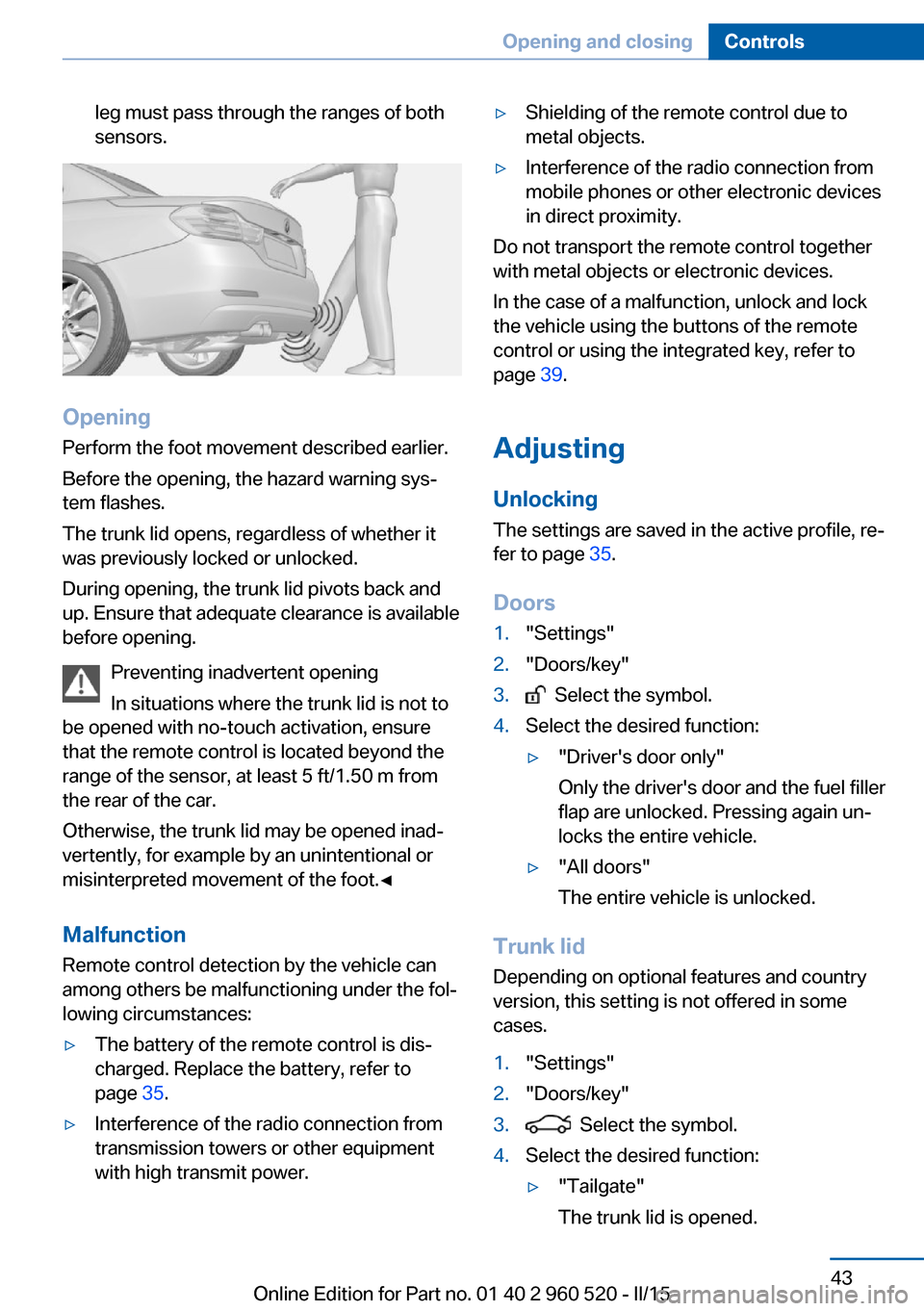
leg must pass through the ranges of both
sensors.
Opening
Perform the foot movement described earlier.
Before the opening, the hazard warning sys‚Äź
tem flashes.
The trunk lid opens, regardless of whether it
was previously locked or unlocked.
During opening, the trunk lid pivots back and
up. Ensure that adequate clearance is available
before opening.
Preventing inadvertent opening
In situations where the trunk lid is not to
be opened with no-touch activation, ensure
that the remote control is located beyond the
range of the sensor, at least 5 ft/1.50 m from
the rear of the car.
Otherwise, the trunk lid may be opened inad‚Äź
vertently, for example by an unintentional or
misinterpreted movement of the foot.‚óÄ
Malfunction
Remote control detection by the vehicle can
among others be malfunctioning under the fol‚Äź
lowing circumstances:
‚Ė∑The battery of the remote control is dis‚Äź
charged. Replace the battery, refer to
page 35.‚Ė∑Interference of the radio connection from
transmission towers or other equipment
with high transmit power.‚Ė∑Shielding of the remote control due to
metal objects.‚Ė∑Interference of the radio connection from
mobile phones or other electronic devices
in direct proximity.
Do not transport the remote control together
with metal objects or electronic devices.
In the case of a malfunction, unlock and lock
the vehicle using the buttons of the remote
control or using the integrated key, refer to
page 39.
Adjusting
Unlocking The settings are saved in the active profile, re‚Äź
fer to page 35.
Doors
1."Settings"2."Doors/key"3. Select the symbol.4.Select the desired function:‚Ė∑"Driver's door only"
Only the driver's door and the fuel filler
flap are unlocked. Pressing again un‚Äź
locks the entire vehicle.‚Ė∑"All doors"
The entire vehicle is unlocked.
Trunk lid
Depending on optional features and country
version, this setting is not offered in some
cases.
1."Settings"2."Doors/key"3. Select the symbol.4.Select the desired function:‚Ė∑"Tailgate"
The trunk lid is opened.Seite 43Opening and closingControls43
Online Edition for Part no. 01 40 2 960 520 - II/15
Page 49 of 247
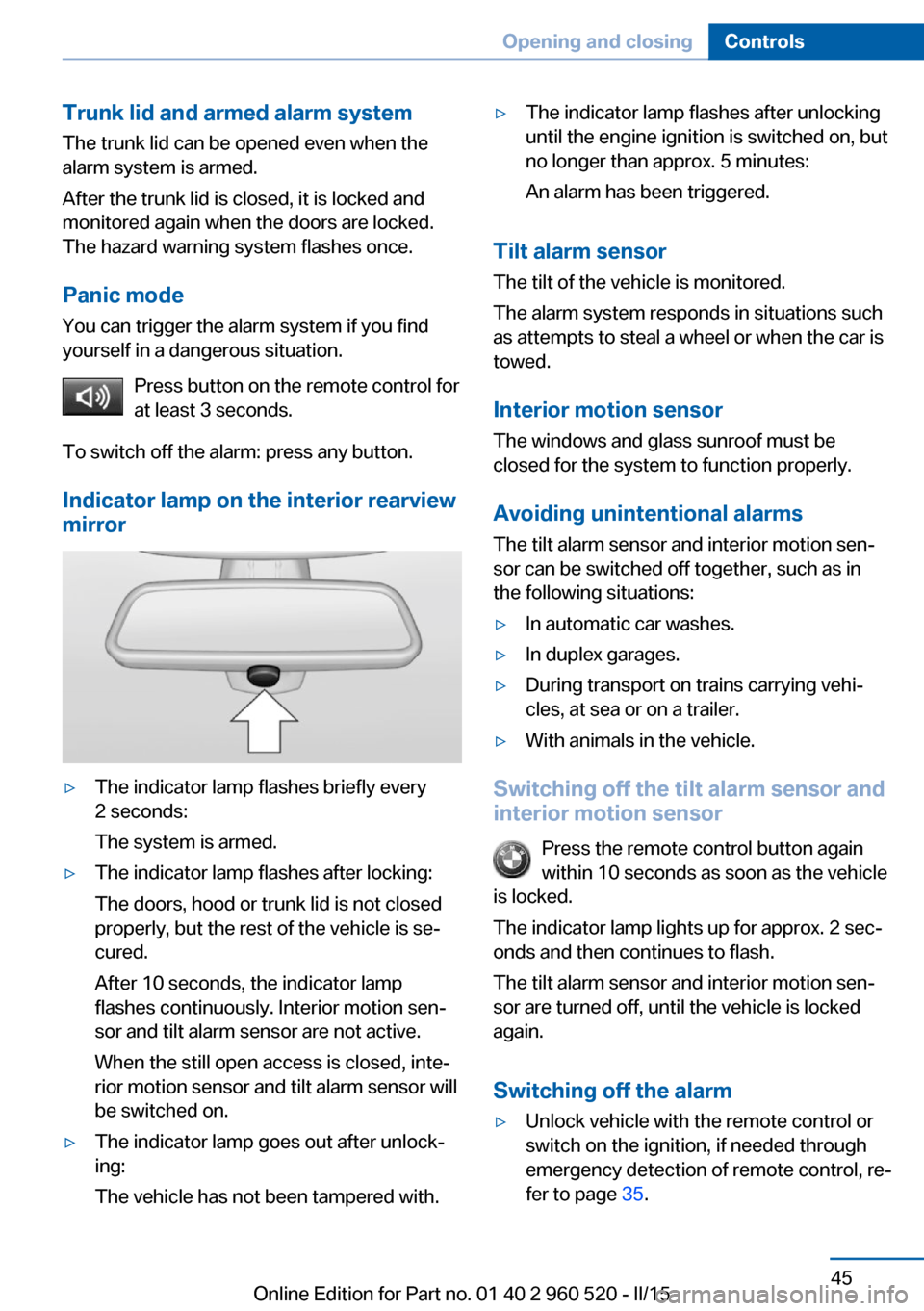
Trunk lid and armed alarm systemThe trunk lid can be opened even when the
alarm system is armed.
After the trunk lid is closed, it is locked and
monitored again when the doors are locked.
The hazard warning system flashes once.
Panic mode
You can trigger the alarm system if you find
yourself in a dangerous situation.
Press button on the remote control for
at least 3 seconds.
To switch off the alarm: press any button.
Indicator lamp on the interior rearview
mirror‚Ė∑The indicator lamp flashes briefly every
2 seconds:
The system is armed.‚Ė∑The indicator lamp flashes after locking:
The doors, hood or trunk lid is not closed
properly, but the rest of the vehicle is se‚Äź
cured.
After 10 seconds, the indicator lamp
flashes continuously. Interior motion sen‚Äź
sor and tilt alarm sensor are not active.
When the still open access is closed, inte‚Äź
rior motion sensor and tilt alarm sensor will
be switched on.‚Ė∑The indicator lamp goes out after unlock‚Äź
ing:
The vehicle has not been tampered with.‚Ė∑The indicator lamp flashes after unlocking
until the engine ignition is switched on, but
no longer than approx. 5 minutes:
An alarm has been triggered.
Tilt alarm sensor The tilt of the vehicle is monitored.
The alarm system responds in situations such
as attempts to steal a wheel or when the car is
towed.
Interior motion sensor The windows and glass sunroof must be
closed for the system to function properly.
Avoiding unintentional alarms The tilt alarm sensor and interior motion sen‚Äź
sor can be switched off together, such as in
the following situations:
‚Ė∑In automatic car washes.‚Ė∑In duplex garages.‚Ė∑During transport on trains carrying vehi‚Äź
cles, at sea or on a trailer.‚Ė∑With animals in the vehicle.
Switching off the tilt alarm sensor and
interior motion sensor
Press the remote control button again
within 10 seconds as soon as the vehicle
is locked.
The indicator lamp lights up for approx. 2 sec‚Äź
onds and then continues to flash.
The tilt alarm sensor and interior motion sen‚Äź
sor are turned off, until the vehicle is locked again.
Switching off the alarm
‚Ė∑Unlock vehicle with the remote control or
switch on the ignition, if needed through
emergency detection of remote control, re‚Äź
fer to page 35.Seite 45Opening and closingControls45
Online Edition for Part no. 01 40 2 960 520 - II/15
Page 73 of 247
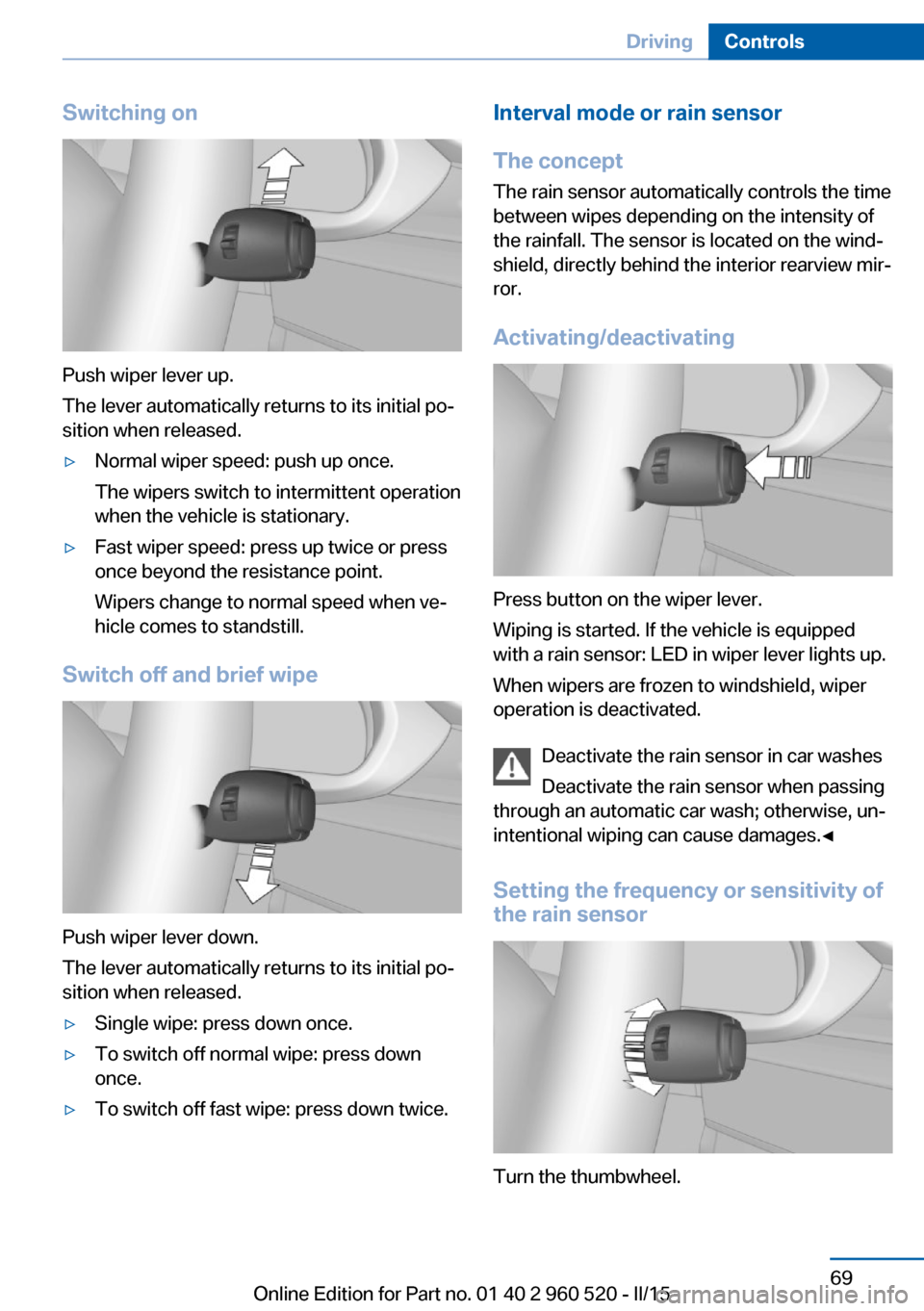
Switching on
Push wiper lever up.
The lever automatically returns to its initial po‚Äź
sition when released.
‚Ė∑Normal wiper speed: push up once.
The wipers switch to intermittent operation
when the vehicle is stationary.‚Ė∑Fast wiper speed: press up twice or press
once beyond the resistance point.
Wipers change to normal speed when ve‚Äź
hicle comes to standstill.
Switch off and brief wipe
Push wiper lever down.
The lever automatically returns to its initial po‚Äź
sition when released.
‚Ė∑Single wipe: press down once.‚Ė∑To switch off normal wipe: press down
once.‚Ė∑To switch off fast wipe: press down twice.Interval mode or rain sensor
The concept The rain sensor automatically controls the time
between wipes depending on the intensity of the rainfall. The sensor is located on the wind‚Äź
shield, directly behind the interior rearview mir‚Äź
ror.
Activating/deactivating
Press button on the wiper lever.
Wiping is started. If the vehicle is equipped
with a rain sensor: LED in wiper lever lights up.
When wipers are frozen to windshield, wiper
operation is deactivated.
Deactivate the rain sensor in car washes
Deactivate the rain sensor when passing
through an automatic car wash; otherwise, un‚Äź
intentional wiping can cause damages.‚óÄ
Setting the frequency or sensitivity of
the rain sensor
Turn the thumbwheel.
Seite 69DrivingControls69
Online Edition for Part no. 01 40 2 960 520 - II/15
Page 88 of 247
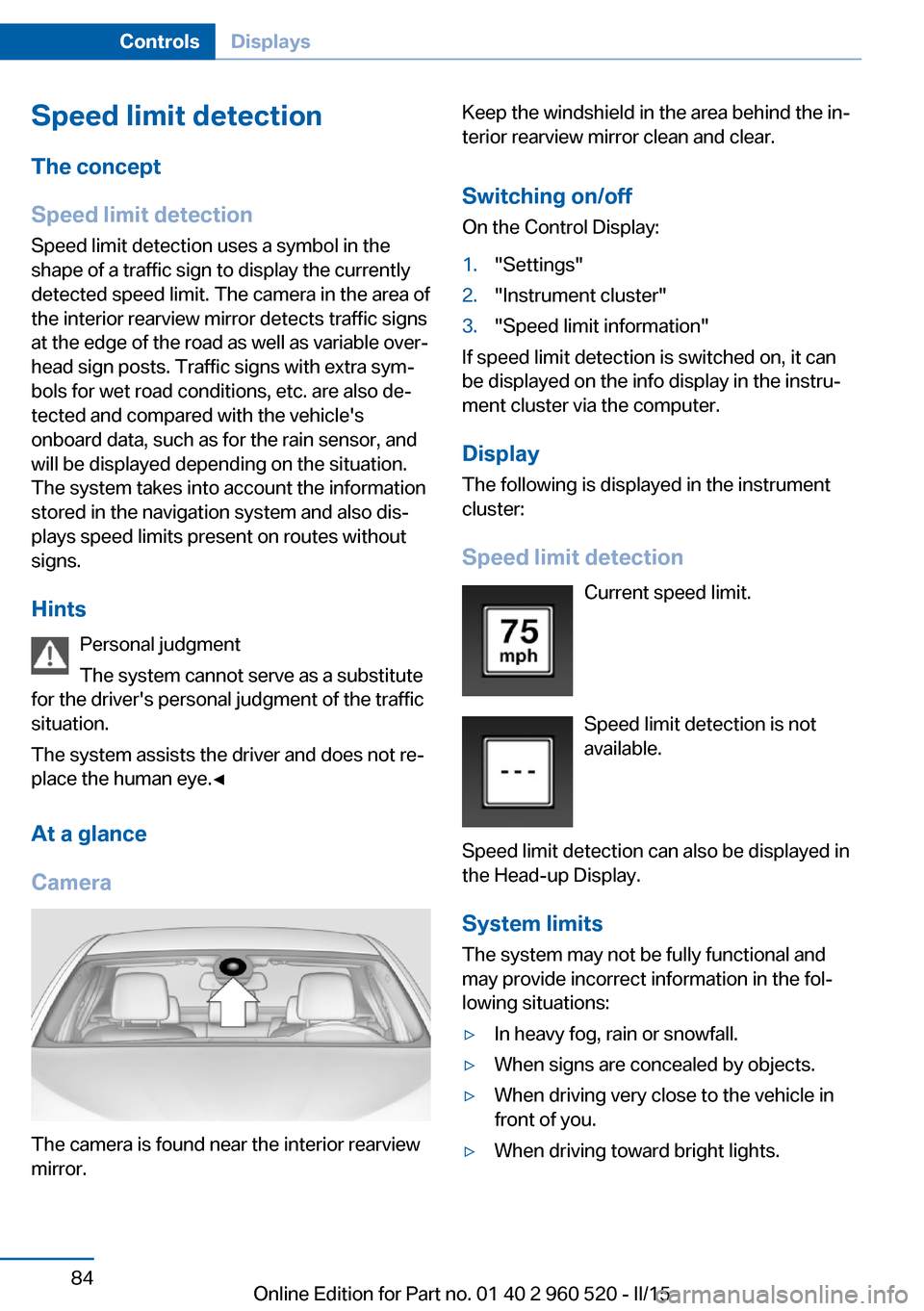
Speed limit detection
The concept
Speed limit detection
Speed limit detection uses a symbol in the
shape of a traffic sign to display the currently
detected speed limit. The camera in the area of
the interior rearview mirror detects traffic signs
at the edge of the road as well as variable over‚Äź
head sign posts. Traffic signs with extra sym‚Äź
bols for wet road conditions, etc. are also de‚Äź
tected and compared with the vehicle's
onboard data, such as for the rain sensor, and
will be displayed depending on the situation.
The system takes into account the information
stored in the navigation system and also dis‚Äź
plays speed limits present on routes without
signs.
Hints Personal judgment
The system cannot serve as a substitute
for the driver's personal judgment of the traffic
situation.
The system assists the driver and does not re‚Äź
place the human eye.‚óÄ
At a glance
Camera
The camera is found near the interior rearview
mirror.
Keep the windshield in the area behind the in‚Äź
terior rearview mirror clean and clear.
Switching on/offOn the Control Display:1."Settings"2."Instrument cluster"3."Speed limit information"
If speed limit detection is switched on, it can
be displayed on the info display in the instru‚Äź
ment cluster via the computer.
Display The following is displayed in the instrument
cluster:
Speed limit detection Current speed limit.
Speed limit detection is not available.
Speed limit detection can also be displayed in
the Head-up Display.
System limits
The system may not be fully functional and
may provide incorrect information in the fol‚Äź
lowing situations:
‚Ė∑In heavy fog, rain or snowfall.‚Ė∑When signs are concealed by objects.‚Ė∑When driving very close to the vehicle in
front of you.‚Ė∑When driving toward bright lights.Seite 84ControlsDisplays84
Online Edition for Part no. 01 40 2 960 520 - II/15
Page 96 of 247
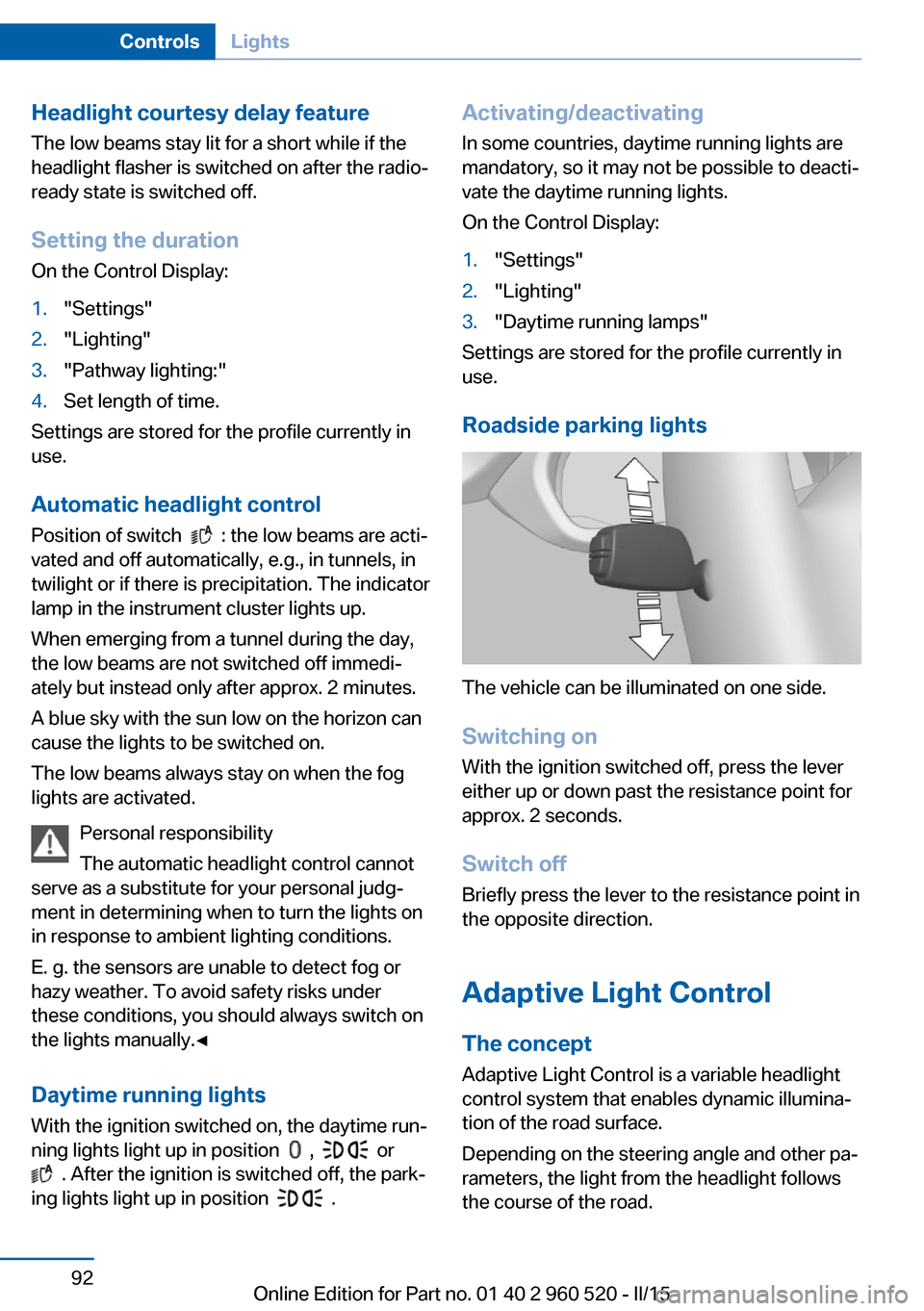
Headlight courtesy delay featureThe low beams stay lit for a short while if the
headlight flasher is switched on after the radio-
ready state is switched off.
Setting the duration
On the Control Display:1."Settings"2."Lighting"3."Pathway lighting:"4.Set length of time.
Settings are stored for the profile currently in
use.
Automatic headlight control
Position of switch
: the low beams are acti‚Äź
vated and off automatically, e.g., in tunnels, in
twilight or if there is precipitation. The indicator
lamp in the instrument cluster lights up.
When emerging from a tunnel during the day,
the low beams are not switched off immedi‚Äź
ately but instead only after approx. 2 minutes.
A blue sky with the sun low on the horizon can
cause the lights to be switched on.
The low beams always stay on when the fog
lights are activated.
Personal responsibility
The automatic headlight control cannot
serve as a substitute for your personal judg‚Äź
ment in determining when to turn the lights on
in response to ambient lighting conditions.
E. g. the sensors are unable to detect fog or
hazy weather. To avoid safety risks under
these conditions, you should always switch on
the lights manually.‚óÄ
Daytime running lights With the ignition switched on, the daytime run‚Äź
ning lights light up in position
, or
. After the ignition is switched off, the park‚Äź
ing lights light up in position
.
Activating/deactivating
In some countries, daytime running lights are
mandatory, so it may not be possible to deacti‚Äź
vate the daytime running lights.
On the Control Display:1."Settings"2."Lighting"3."Daytime running lamps"
Settings are stored for the profile currently in
use.
Roadside parking lights
The vehicle can be illuminated on one side.
Switching on With the ignition switched off, press the lever
either up or down past the resistance point for
approx. 2 seconds.
Switch off Briefly press the lever to the resistance point in
the opposite direction.
Adaptive Light Control The concept
Adaptive Light Control is a variable headlight
control system that enables dynamic illumina‚Äź
tion of the road surface.
Depending on the steering angle and other pa‚Äź rameters, the light from the headlight follows
the course of the road.
Seite 92ControlsLights92
Online Edition for Part no. 01 40 2 960 520 - II/15
Page 103 of 247
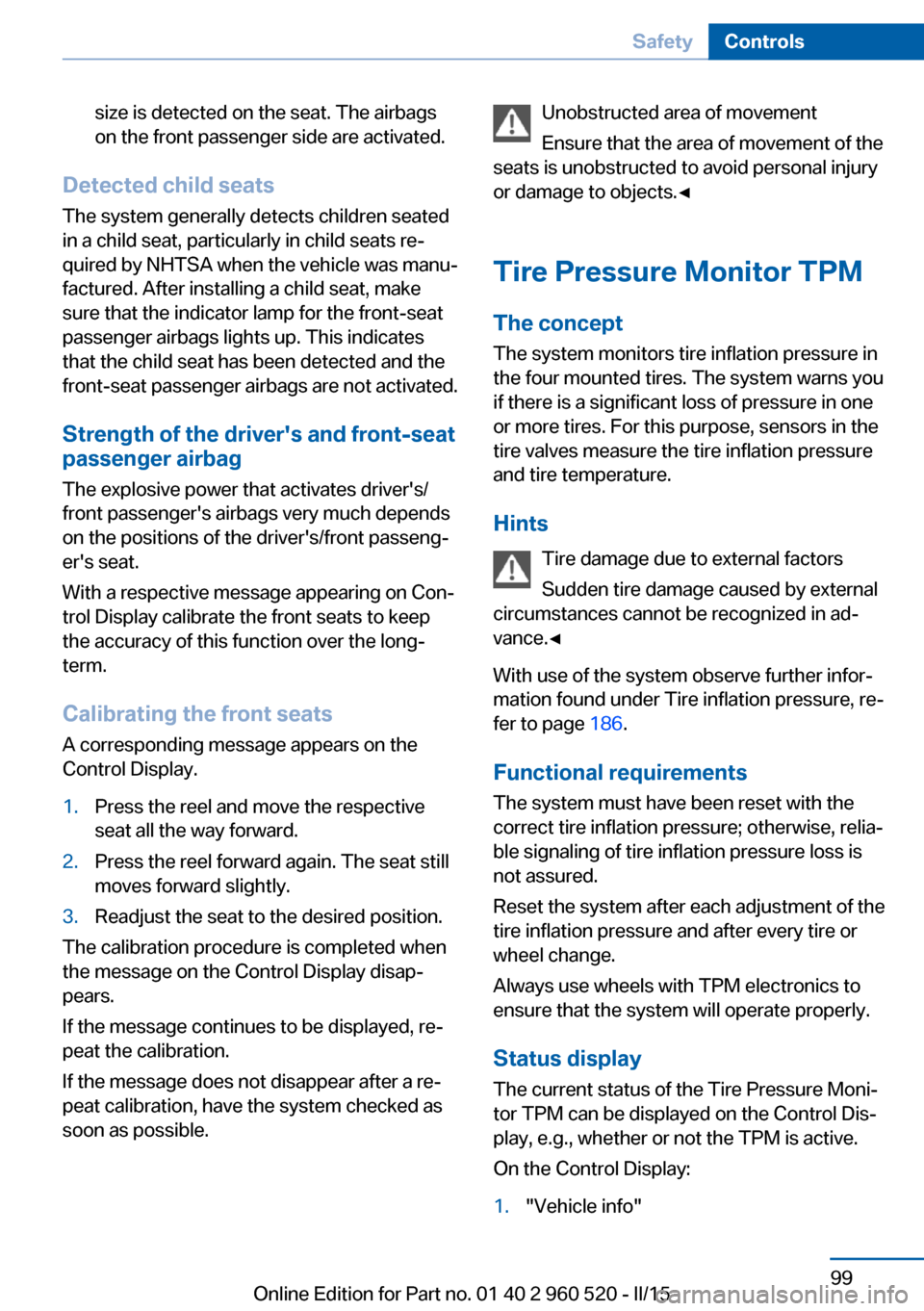
size is detected on the seat. The airbags
on the front passenger side are activated.
Detected child seats
The system generally detects children seated
in a child seat, particularly in child seats re‚Äź
quired by NHTSA when the vehicle was manu‚Äź factured. After installing a child seat, make
sure that the indicator lamp for the front-seat
passenger airbags lights up. This indicates
that the child seat has been detected and the
front-seat passenger airbags are not activated.
Strength of the driver's and front-seat
passenger airbag
The explosive power that activates driver's/
front passenger's airbags very much depends
on the positions of the driver's/front passeng‚Äź er's seat.
With a respective message appearing on Con‚Äź
trol Display calibrate the front seats to keep the accuracy of this function over the long-
term.
Calibrating the front seats
A corresponding message appears on the
Control Display.
1.Press the reel and move the respective
seat all the way forward.2.Press the reel forward again. The seat still
moves forward slightly.3.Readjust the seat to the desired position.
The calibration procedure is completed when
the message on the Control Display disap‚Äź
pears.
If the message continues to be displayed, re‚Äź
peat the calibration.
If the message does not disappear after a re‚Äź
peat calibration, have the system checked as
soon as possible.
Unobstructed area of movement
Ensure that the area of movement of the
seats is unobstructed to avoid personal injury
or damage to objects.‚óÄ
Tire Pressure Monitor TPM The concept
The system monitors tire inflation pressure in
the four mounted tires. The system warns you
if there is a significant loss of pressure in one
or more tires. For this purpose, sensors in the
tire valves measure the tire inflation pressure
and tire temperature.
Hints Tire damage due to external factors
Sudden tire damage caused by external
circumstances cannot be recognized in ad‚Äź
vance.‚óÄ
With use of the system observe further infor‚Äź
mation found under Tire inflation pressure, re‚Äź
fer to page 186.
Functional requirements
The system must have been reset with the
correct tire inflation pressure; otherwise, relia‚Äź
ble signaling of tire inflation pressure loss is
not assured.
Reset the system after each adjustment of the
tire inflation pressure and after every tire or
wheel change.
Always use wheels with TPM electronics to
ensure that the system will operate properly.
Status display
The current status of the Tire Pressure Moni‚Äź
tor TPM can be displayed on the Control Dis‚Äź
play, e.g., whether or not the TPM is active.
On the Control Display:1."Vehicle info"Seite 99SafetyControls99
Online Edition for Part no. 01 40 2 960 520 - II/15
Page 112 of 247
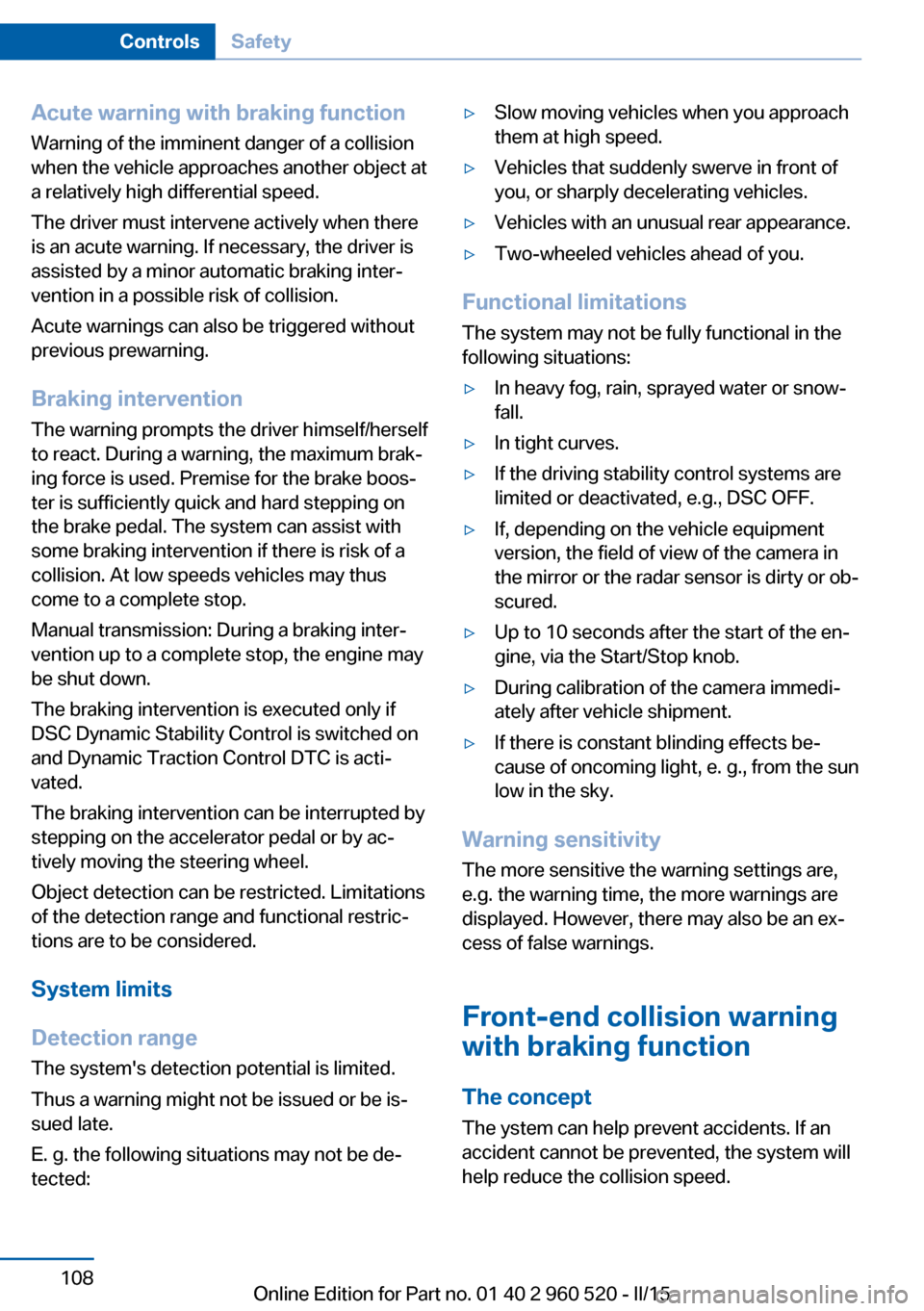
Acute warning with braking function
Warning of the imminent danger of a collision
when the vehicle approaches another object at
a relatively high differential speed.
The driver must intervene actively when there
is an acute warning. If necessary, the driver is
assisted by a minor automatic braking inter‚Äź
vention in a possible risk of collision.
Acute warnings can also be triggered without
previous prewarning.
Braking intervention
The warning prompts the driver himself/herself
to react. During a warning, the maximum brak‚Äź
ing force is used. Premise for the brake boos‚Äź
ter is sufficiently quick and hard stepping on
the brake pedal. The system can assist with
some braking intervention if there is risk of a
collision. At low speeds vehicles may thus
come to a complete stop.
Manual transmission: During a braking inter‚Äź
vention up to a complete stop, the engine may
be shut down.
The braking intervention is executed only if
DSC Dynamic Stability Control is switched on
and Dynamic Traction Control DTC is acti‚Äź
vated.
The braking intervention can be interrupted by
stepping on the accelerator pedal or by ac‚Äź
tively moving the steering wheel.
Object detection can be restricted. Limitations
of the detection range and functional restric‚Äź
tions are to be considered.
System limits
Detection range
The system's detection potential is limited.
Thus a warning might not be issued or be is‚Äź
sued late.
E. g. the following situations may not be de‚Äź
tected:‚Ė∑Slow moving vehicles when you approach
them at high speed.‚Ė∑Vehicles that suddenly swerve in front of
you, or sharply decelerating vehicles.‚Ė∑Vehicles with an unusual rear appearance.‚Ė∑Two-wheeled vehicles ahead of you.
Functional limitations
The system may not be fully functional in the
following situations:
‚Ė∑In heavy fog, rain, sprayed water or snow‚Äź
fall.‚Ė∑In tight curves.‚Ė∑If the driving stability control systems are
limited or deactivated, e.g., DSC OFF.‚Ė∑If, depending on the vehicle equipment
version, the field of view of the camera in
the mirror or the radar sensor is dirty or ob‚Äź
scured.‚Ė∑Up to 10 seconds after the start of the en‚Äź
gine, via the Start/Stop knob.‚Ė∑During calibration of the camera immedi‚Äź
ately after vehicle shipment.‚Ė∑If there is constant blinding effects be‚Äź
cause of oncoming light, e. g., from the sun
low in the sky.
Warning sensitivity
The more sensitive the warning settings are,
e.g. the warning time, the more warnings are
displayed. However, there may also be an ex‚Äź
cess of false warnings.
Front-end collision warning
with braking function
The concept The ystem can help prevent accidents. If an
accident cannot be prevented, the system will help reduce the collision speed.
Seite 108ControlsSafety108
Online Edition for Part no. 01 40 2 960 520 - II/15